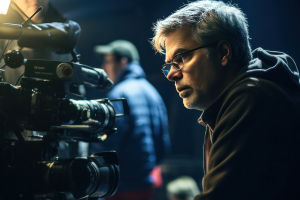As film lovers, we've all experienced that emotional rush when the music swells or when a stunning visual captivates us on screen.
But have you ever stopped to think about how filmmakers use visual style — particularly color, lighting, and camera techniques — to shape our perception and emotions?
It's more than just decoration or eye candy. These elements play a vital role in crafting the mood, enhancing the narrative, and connecting us with the characters. Let's dive into the artistry behind these techniques and explore how they transform a movie from just a story into an experience.
The Power of Color: More Than Just Aesthetic
Color in film is often much more than a simple visual choice; it's a tool used by directors to convey deeper meanings, evoke emotional responses, and create visual themes. Take a moment to think of iconic films that use color creatively — The Grand Budapest Hotel (2014), with its playful use of pastel hues.
Colors have psychological implications. For example, reds and oranges can convey warmth, energy, or danger, while blues and greens may evoke calm, sadness, or serenity. In The Sixth Sense (1999), director M. Night Shyamalan uses red to signify life and death, creating tension and subtly guiding the viewer's emotional journey. We, as the audience, may not consciously pick up on these cues, but they significantly impact how we emotionally connect with what's happening on screen.
Light and Shadow: Crafting Atmosphere
Lighting is another crucial tool in a filmmaker's visual toolkit. It's not just about illuminating the scene; it's about shaping how we perceive a space, a character, or an entire atmosphere. A well-lit scene can make everything feel inviting and safe, while low-key lighting — shadows, contrast, and minimal light — can create suspense, mystery, or danger.
Lighting can also reveal inner emotions. For example, a character bathed in soft, warm light may seem vulnerable or innocent, while harsh, cold lighting can make them appear menacing or untrustworthy. This technique is frequently used in thrillers and horror films to increase tension, but it can also provide subtle character insights. In Citizen Kane (1941), Orson Welles uses deep shadows and dramatic lighting to reveal Kane's isolation and inner turmoil, adding a psychological layer to the visual storytelling.
The Camera's Eye: Framing and Perspective
The way a scene is framed can dramatically affect how we interpret it. Directors use different camera angles, movements, and focal lengths to guide our perception of the world on screen. A wide-angle shot can make a character appear small and insignificant within a vast, intimidating world, while a close-up shot can highlight a character's emotions or thoughts.
Camera movements also play a crucial role. Tracking shots, for example, can create a sense of fluidity, drawing us deeper into the action, while a static shot can make us feel detached or contemplative.
Emotional Impact: The Art of Visual Storytelling
Together, these elements of color, light, and camera work do more than just set the stage — they evoke emotions and guide the audience's emotional journey. For example, the eerie, dimly lit scenes in The Witch (2015) create an overwhelming sense of dread and isolation, pulling the audience into the characters' psychological horror. Meanwhile, in La La Land (2016), the vibrant, colorful palette and dynamic camera movements give a sense of youthful optimism and joy, balancing the bittersweet elements of the story with beauty.
The combination of these visual choices allows the filmmaker to communicate subtext and create a heightened emotional response. While a film's narrative and dialogue tell us what is happening, the visual style tells us how to feel about it. This is why the visual language of cinema is so powerful — it speaks directly to our emotions without the need for words.
The Role of Filmmakers in Crafting Visual Style
Of course, none of this would be possible without the creative vision of the filmmakers. Directors, cinematographers, production designers, and costume designers all work together to create a cohesive visual aesthetic.
These visual choices are not merely decorative. They form the backbone of the film's narrative and themes. They help set the tone, provide subtle commentary, and engage the viewer in a way that mere words cannot.
Visual Style as Narrative
In the end, the visual style of a film is much more than a set of artistic choices. It's an essential part of storytelling that shapes how we perceive the narrative, how we feel about the characters, and how we engage with the emotional undertones of the film. The use of color, light, shadow, and camera techniques can deepen our connection to the film and elevate the overall experience. It's a language that speaks directly to our senses, creating a bond between the audience and the story.
So, next time we sit down to watch a film, let's pay attention not only to the plot, but to how the visuals shape our perception. What do the colors, lighting, and camera angles tell us? How do they make us feel? The beauty of film lies not just in the story, but in the way it is told — visually. What's your favorite visual style in film? Let us know in the comments!


